Used by The Beatles, The Rolling Stones, David Bowie and Lou Reed to name just a few. Discover the history and sound of these original Trident Studios monitoring loudspeakers.
Trident Studios was a recording studio in London. Opening in 1968, it remained open until 1981 and in that time, Trident Studios coined itself one of the most uniquely important recording studios in the world.
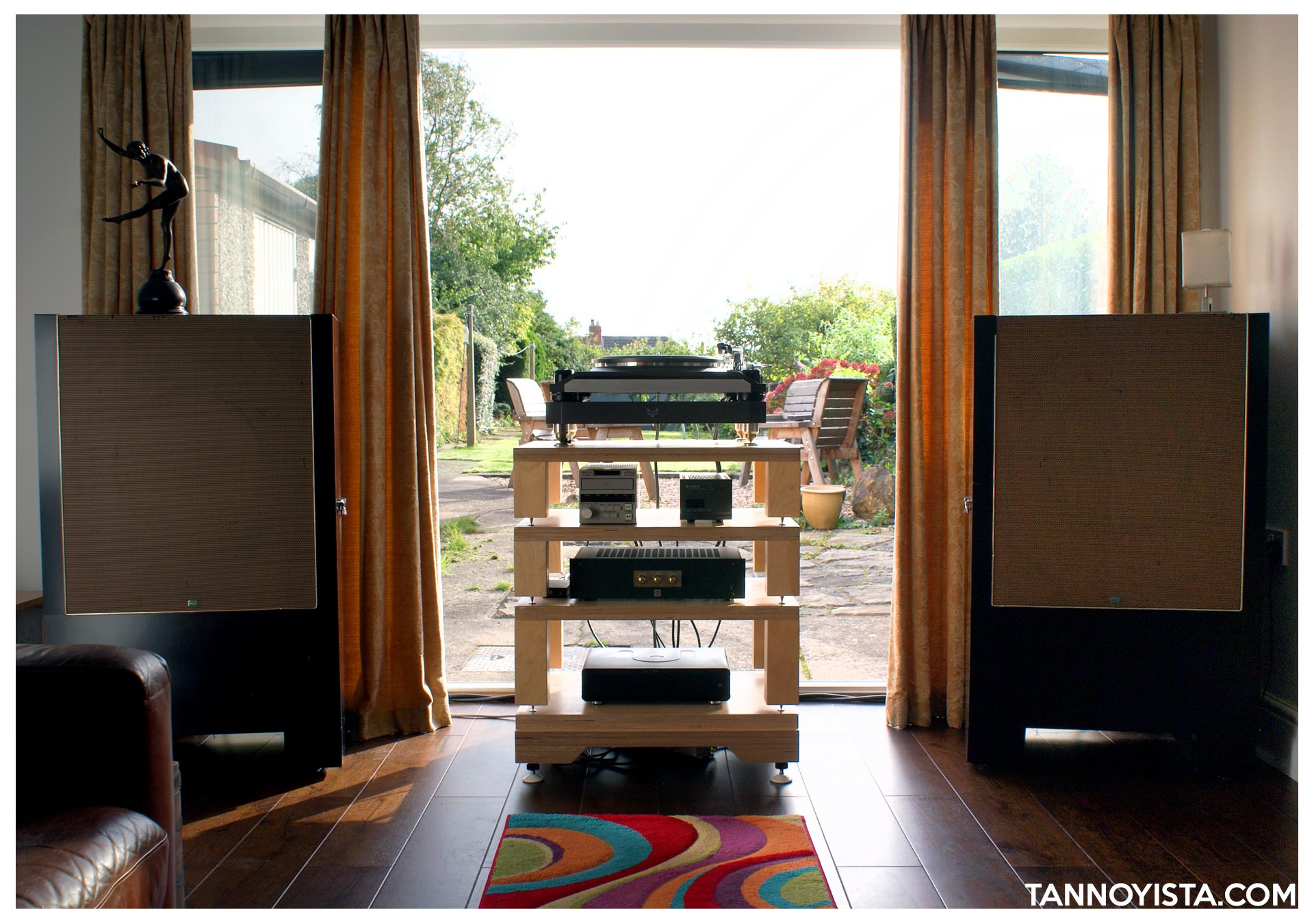 |
| The Tannoyista system with the Trident Studios Lockwood Majors |
| Contents |
|---|
|
|
|
|
|
|
|
|
|
|
About Trident Studios, London
The legacy of Trident Studios is now legendary but, alas, today the studio is no more, in fact, it's now a very upmarket townhouse which is sad to see.
Since its closure, the studio has operated under various names and although now in a different location in London, it's now 'Trident Sound Studios' and they specialise in sound recording and mixing for TV.
But the ghostly reverberations of the studio still ring loud in our music and culture today, and in many ways just as loud as Abbey Road. Within a small window of time from 1968 to around 1978, the control room at Trident included 4 Lockwood Major monitoring loudspeakers for hearing back mixes.
That amazing 10-year window in time changed popular music forever and included some of the most prolific artists using the studio such as The Beatles, The Rolling Stones, David Bowie, Queen, Lou Reed, T-Rex, Elton John, The Small Faces and others. This is the story of two of the actual loudspeakers used to make those amazing albums.
Discovering the original Trident Lockwood Majors
There's nothing like hearing BIG speakers. The amount of energy and spatial energy is totally immersive. Back in the early 90s, I used to work in a small studio where we used such speakers. The sound was totally astonishing.
Of course, a studio control room is treated to a vast degree but even with a typical living room space, you can still get a lot of the magic.
So, in 2013, my love for large loudspeakers began. At that time, I was using some Lockwood Universal loudspeakers which were pretty good but when I had the chance to move to the ultimate beasts, I just had to do it.
The Universals came from a friend and after previously discovering they originated from CTS studios and then Toe Rag Studios, it was pretty much a given that at some point in the past, my Majors would've also been resident in a sound studio of some calibre.
So I started to investigate. So in 2015, I sold the Lockwood Universal cabinets to go bigger and, yes... much better. Bring on the Lockwood Majors.
The seller of the Majors was an old gent who was in poor health. He was selling off a lot of great kit that had been in storage for over 40 years. He had a set of Bates microphone preamps, a Studer B67 and loads of old tape which in hindsight, I really should have bought.
I sent him an email asking if he had any information but it wasn't until 2016 that I heard back from him. In fact, his email accidentally slipped into my spam folder.
 |
| The Trident Lockwoods in situe today |
He remembered the cabinets belonging to either a producer or a technician who worked at a studio in west London and was told there were 4 of them against a wall in the studio. The guy rescued a pair when the studio was refitted back in or around the late '70s.
So, I had a quick look on the net and came up with some pictures of a studio back in the day which were really quite astonishing, they show a wall of 4 black Lockwood Major speakers. So I contacted the seller again to ask if he could find any more details.
He got back to me and said that they came from a place in Soho, Trident Studios?
To be honest, I was half expecting him to say Olympic Studios as I remembered a small clip from the Stones movie, 'Gimmie Shelter'. In a small clip, Keith Richards is in front of some Lockwoods when they are mixing 'Little Queenie'.
But there was something which didn't add up in regards to that. The mixing desk in that clip was a Trident desk and so the official information on the film literature is incorrect.
Here is a picture of Keith Richards standing in front of the Majors along with a picture of Norman Sheffield, the founder of Trident and the Trident desk.
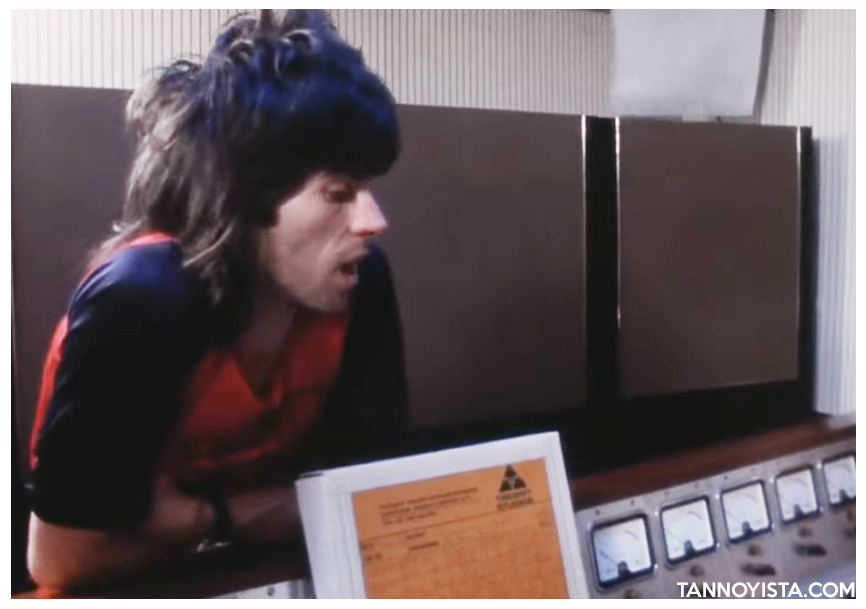 |
Keith Richards in front of the now Tannoyista Lockwood Majors - Image © 20th Century Fox |
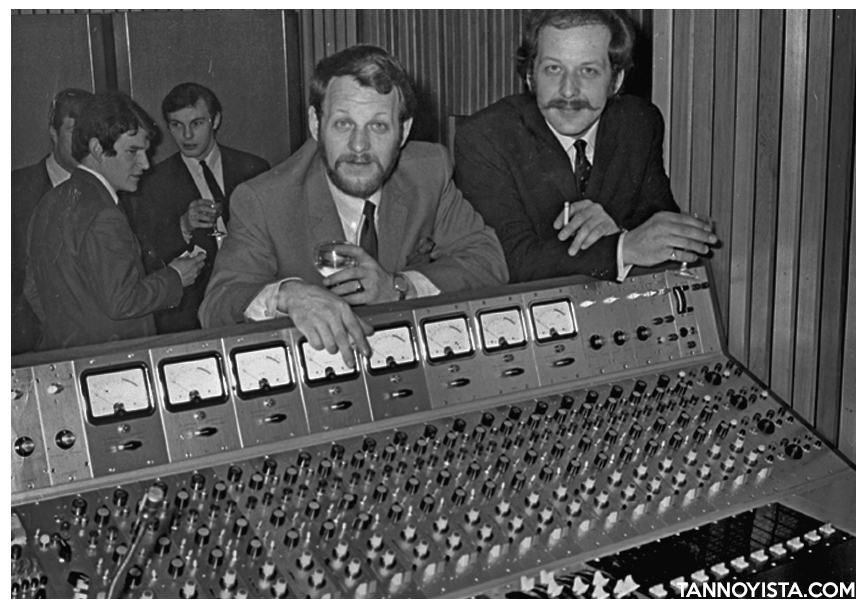 |
| Norman Sheffield. The founder of Trident Studios at the opening of the Studio |
 |
| The wonderful Trident desk with the 4 Lockwood Majors |
Apart from the decor which commonly changed with refits, treatment tweaks and equipment updates, (as does mine), it shows the Stones were in Trident and not Olympic.
We Brits had a fascination for Tannoy speakers back then (and still have... well, I do) but it wasn't until the Major came onto the scene that a studio reference standard was born, especially here in the UK. Olympic, Chappell and Trident all had Lockwood Majors.
My story kind of stopped there for a few years. Given what I gleaned from the seller about these speakers I was pretty confident that they came from Trident.
 |
| Still here and sounds wonderful |
In early 2020 I decided to fit my Tannoyista crossovers inside the cabinets for a little experiment when I found something which nailed their origin.
Externalising the crossovers is based on good grounds but I wanted to know what the effects were by placing them in a certain position inside the large cabinets.
Find out more information on the Tannoyista Crossovers below:
I had them fixed into the back/bottom area of the cabinet, just above the port by constructing a small wooden frame as opposed to laying them flat in the base.
These cabinets sometimes had small amplifiers fitted into the base thus becoming an active speaker. Pictures of the Tannoyista crossovers being installed inside the Major cabinets.
 |
| The Tannoyista external crossovers |
 |
| Experimental insallation inside the Lockwood Majors |

As we were installing them, we needed to drag one a little way across the carpet. As I held the inside top lip of the opening I felt a smooth part attached to the inside. It wasn't until I looked further inside that I discovered a rectangular plate attached by two screws.
The older Lockwoods came with two types of I.D. plates. The square I.D plate is normally fixed to the top left of the cabinet's back panel and the other type is normally located on the bottom centre of the back panel.
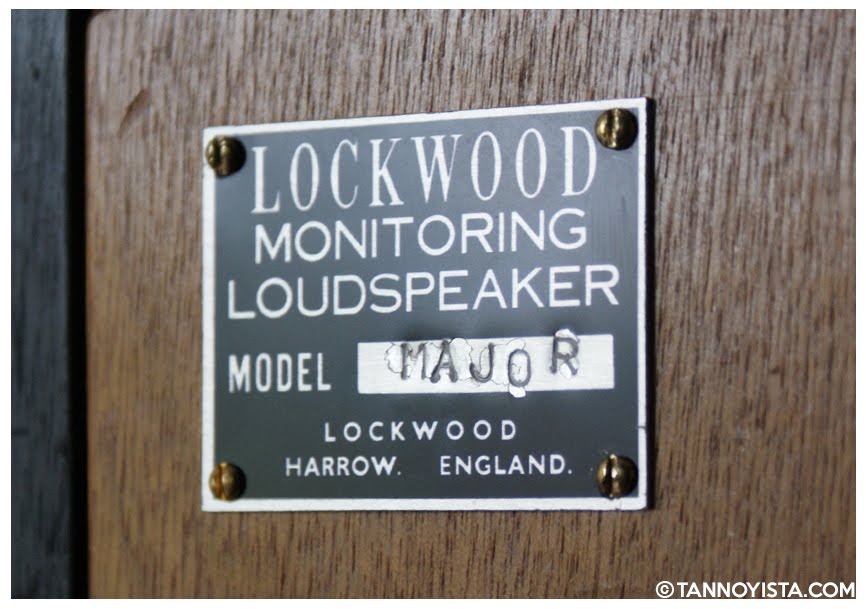 |
| I.D plate on the back of the Majors - (top left of left-hand loudspeaker) |
Additionally, the top I.D. plate is only present on one of a pair of loudspeakers. An old friend who worked in the industry told me that the badged loudspeaker was to show the left-hand loudspeaker.
Unscrewing the inside plate revealed this. Stamped into the plate is 'LS2 TRIDENT'
 |
| The second I.D plate, once hidden, is now where it should be |
One of the once-hidden I.D plates. It's now attached to the back panel where 'still' nobody can see it. Upon looking inside the other loudspeaker cabinet, I couldn't find the other I.D plate so out of curiosity I unstapled a strip of sound insulation which wasn't present on my other loudspeaker and, behold, there it was, the other plate.
This time the plate said 'LS3 TRIDENT'
So I assume that LS2 and LS3 correspond to Loudspeaker 2 and Loudspeaker 3. In a monitoring environment, speakers 2 & 3 would correspond to the centre two monitors with 1 & 4 being the outer monitors.
The elephant-sized question here is why on earth were they attached to the inside of the cabinet, completely out of sight?
A special order? A mistake made at the factory? Or even perhaps one of the technical people did it to avoid confusion if they were to ever move or swap them over? Lockwood also sometimes stamped a serial number into the wood surround on the back of some loudspeakers.
My Majors also have a number stamped to which are in sequence. #1724/2 and #1725/3 but, alas, Lockwood retained no record of serial numbers which is unfortunate.
I guess they must have made quite a lot in a short period of time. The I.D. plates are now attached to the back panel where they should be. The design of my Majors is also slightly different to the general ones too.
The difference is that the front lower panel is not present, making them open at the bottom. It seems to me that Lockwood made this design to order. As in the photos, Trident had 4 speakers in one studio.
It's pretty much a given that these are part of that set of speakers and it's nice to know that they have remained together for all these years. But, knowing the whereabouts of 1 & 4 would be a great thing to know.
 |
| The Lockwoods standing proud at Trident - Image © Trident Studios |
So again, if anyone could help, that would be great. I can only presume that the missing speakers are marked in the same (hidden) way so if you have any which are identical to these please do check the inside top lip of the speakers.
Who used these actual monitors?
From 1968, many artists used Trident Studios and in that initial period bands like The Beatles, David Bowie, Elton John, Lou Reed and Queen to name more than a few. It's amazing to think that tracks such as Hey Jude and Space Oddity were mixed using these monitors.
Here is a list of artists using Trident Studios from 1968 until 1978
David Bowie
After some further investigating, I found some nice photos of the speakers at Trident. Not only that but none other than the late David Bowie standing in front of them.
David Bowie, also used these speakers for mixing the albums, Hunky Dory and Ziggy Stardust and the Spiders from Mars.
Queen, T-Rex, Lou Reed and many others also used these actual speakers to master some of the most iconic and legendary music ever.
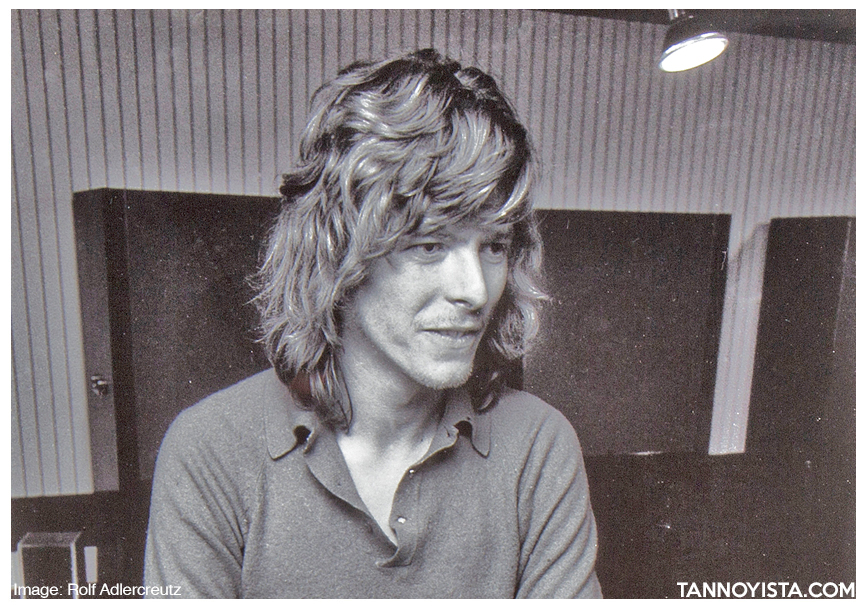 |
| David Bowid in front of the now tannoyista Lockwoods |
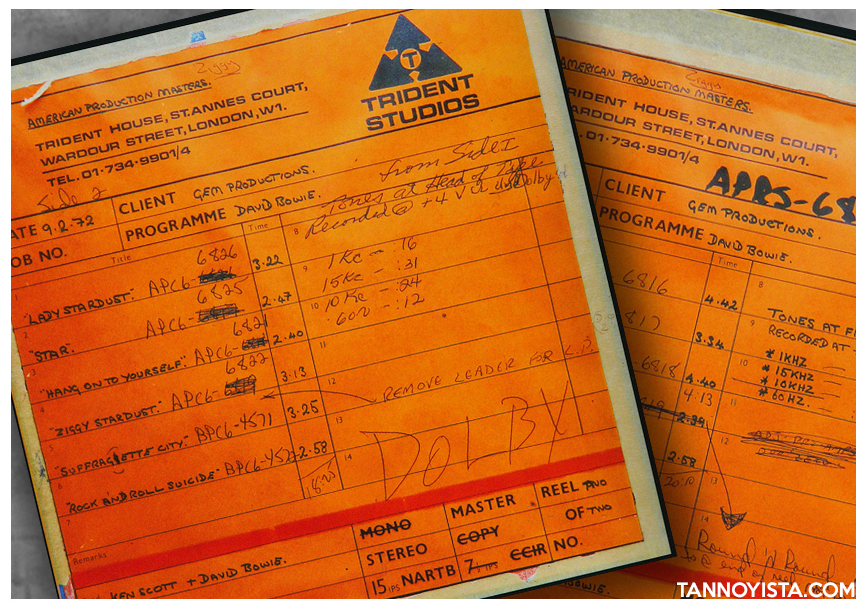 |
| David Bowies Trident Tapes |
The Beatles
It was The Beatles who persuaded George Martin at Abbey Road to get rid of the Altecs and the smaller JBL's and refit with Majors.
To hear 4 of these speakers in a studio must have been amazing. Want to know what Sir Paul McCartney had to say?
Here is a great little snippet from an interview with Sir Paul McCartney.
Q: "On the end of ‘Hey Jude’ you can quite clearly hear someone swearing. Why did you decide not to remove that?
Paul McCartney: I don’t think we noticed until later. We recorded it in Trident Studios, which is in Soho, which is a studio that we used if we couldn’t get in Abbey Road.
So, we were all there and we did ‘Hey Jude’, and we were listening back on these six-foot-tall tannoy speakers, and there were four of them in the room so it was like living in the song, which is how you can impair your hearing!
So we just whacked it up real loud and listened to it. It was more of an experience than anything. Then we took it back to Abbey Road, and we were more preoccupied with the thing that we’d fooled ourselves with the sound - it sounded great on these great big speakers, but when we put it on the naff speakers that we always tested everything on, which was just a couple of very ordinary JBLs, it sounded crap.
We had to put in like full bass and full treble; the engineers really had to load it back up, cos we’d fooled ourselves on the sound. I think we were so preoccupied with that, that we didn’t really listen to it until it was too late, and then we listened to it very carefully on headphones and sort of thought, ‘Oh, shit!’ Because there were a lot of vocal part harmonies, you know: [sings] “And any time you feel the... Aaaahhhhhh...” A lot of long notes, and I think probably someone made a mistake and went, ‘Aw, fuck it!’ or whatever, and that just found itself in the mix. It wasn’t intentional. "
 |
| Booking invoice for The Beatles at Trident, 19th March 1969 |
Abbey Road used the LE.1.S MK3 Majors in the Studio 1 control room which were also used at Trident in their machine room. The LE1S Major had pretty much the same dimensions as a reference Major but was slightly taller due to the speaker aperture being higher to fit a front-firing port rather than a downwards firing port.
Abbey Road also 'allegedly' used Tannoys Lancasters sat on tea trollies. Another London studio called Basing Street (Sarm Studios) also used Majors which were clad in red/orange. Pete Townsend also had an orange pair and Elton John also had a pair in light blue.
Joe Meek also used one of the early Major designs (also a LE1 type) which he used to cut his mono lacquers with.
The construction of the Lockwoods
The construction of the Major cabinets is quite simple compared to some of today's designs. But you simply can't write a basic design as 'not as good as...'. Many things in audio rely on simple design and these are no exception. The advantage the Majors have is 'SIZE' and weight. Being able to house 15" drivers is still something of a luxury.
So with the Tannoy Gold (or Red) drivers, there is a magical synergy. The cabinets are encased in 1,5mm Formica which forms the rigid structure over the large sub straights. Remove the Formica and you will ruin the sound.
The grill fabric is a very complex weave. Not only that but the materials used are a form of nylon/plastic mono-fibre blend. When you look at it up close, it's really quite amazing. The fabric fitted to the Majors is taught and springy, like a trampoline. It's not baggy and has a totally different feel to conventional speaker grill fabric.
When fitted, it needs to be warmed slightly to help with flexibility. It then needs to be pulled taught horizontally and secured with staples and glue on each side. Needless to say, it's recommended to have an expert hand to do the job right.
And right it must be. The original manufacturer of this fabric was a company called Fothergill & Harvey. Today they are 'The Fothergill Group' and are still based in Lancashire, UK. But, unfortunately, they no longer manufacture this material, in fact, they haven't made any in many decades.
Originally named 'Tygan', the fabric was made for automotive upholstery. Production started in the 1940s up until the mid-1970s. Fothergill still manufactures fabrics but they now consist of higher-performance yarns such as glass, aramid and carbon.
Sadly they no longer make synthetic monofilament yarns or have any old stock material available.
Lockwood used this material on quite a few of the models including the Majors and Universals. Some of the smaller models also used this fabric. It came in two shades, a beige brown (shown) and a darker red colour.
 |
| A close-up of the Lockwood grille fabric |
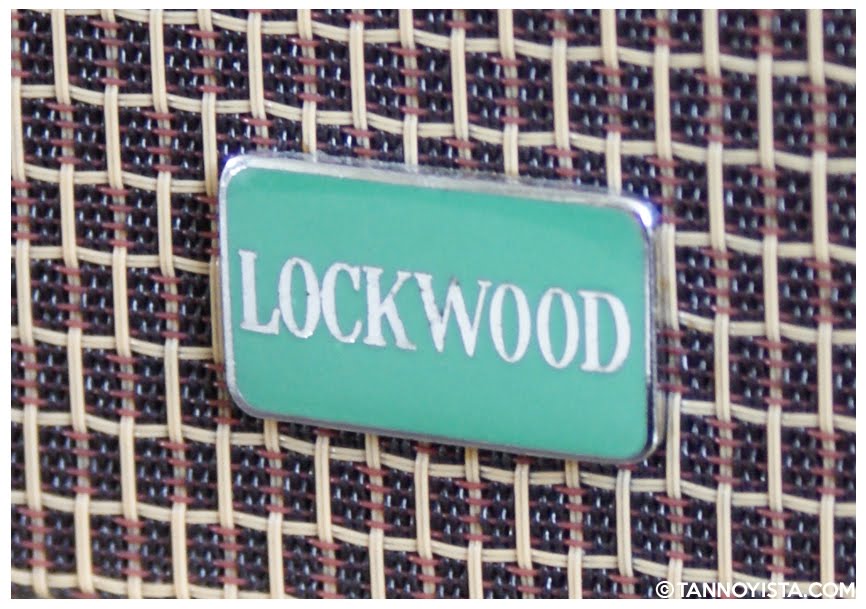





 All the photographs and images on this site are copyright.
All the photographs and images on this site are copyright.
0 comments